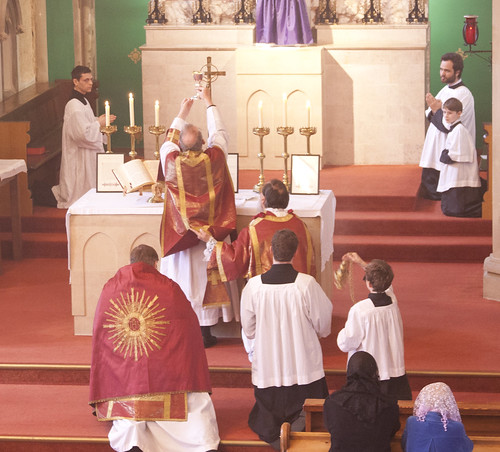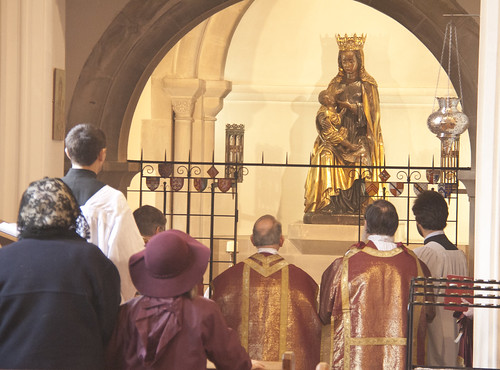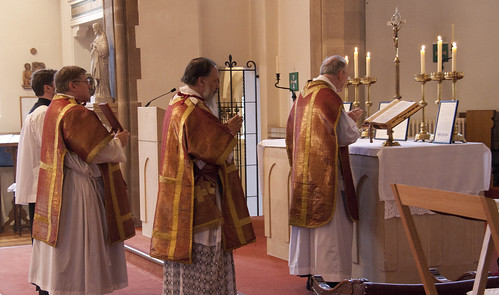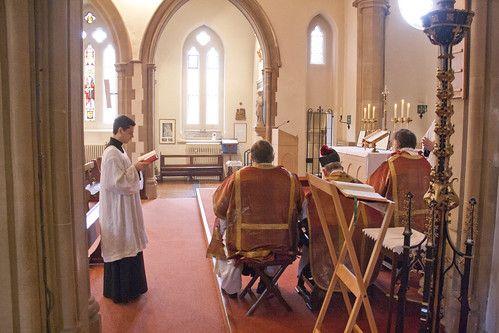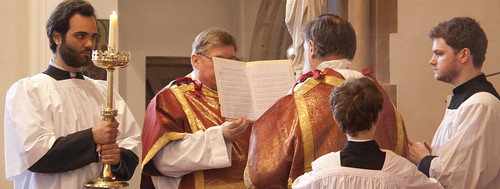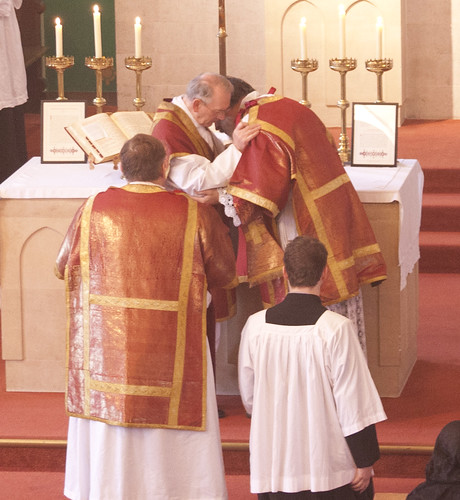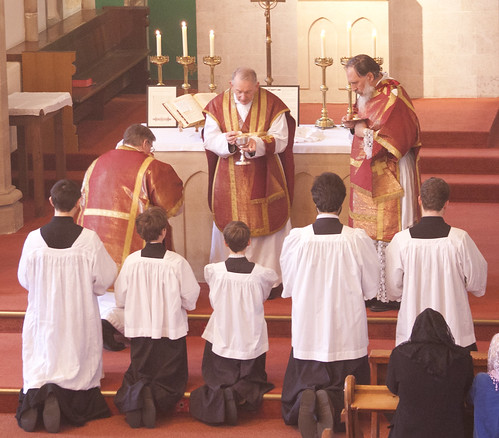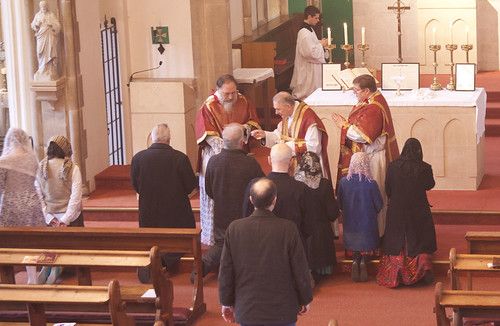Chairman's Blog
Pilgrimage to Caversham 2017: photos
Our Lady and St Anne, Caversham, houses the official Marian Shrine of the Archdiocese of Birmingham, crowned by Papal mandate: the shrine image is below.
It was the Ember Saturday of Lent, and we had five 'prophecies', Old Testament readings, before the Epistle and Gospel, rather like the Easter Vigil.
Support the work of the LMS by becoming an 'Anniversary Supporter'.
Me on Newsnight: last night
Last night I was, briefly, a talking head on Newsnight, talking about Pope Francis. The main problem was to get the presenter - and, I suppose, the audience - to have the smallest understanding of the concept of Catholic doctrine, what the Pope's function is, and what schism means. That didn't really leave much time for anything else.
In the UK you can see the whole programme online here, from 18:30 - 22:16 mins:
http://www.bbc.co.uk/.../episode/b08hwb7d/newsnight-10032017
They've put a little clip on Twitter:
https://t.co/2FcLa0m5fN
Maybe someone can let me know if the whole thing goes up on YouTube.
Support the work of the LMS by becoming an 'Anniversary Supporter'.
The empty Imperial throne
Over on Rorate Caeli I've posted an article by James Bogle, former FIUV President, LMS Committee member and author of a book on Bl Charles of Austria, on the role formerly played by the Holy Roman Emperors (and indeed by the Christian emperors of Rome) in Church affairs, and the consequences of the disappearance of the Emperor from Europe's life.
It is easy to point to periods of conflict between Pope and Emperor. Conflict is inevitable over time and itsn't always unhealthy. What is worse than the conflict between the two pillars of Christian society, the spiritual and the temporal, is the disappearance for practical purposes of one side of the conflict: the disappearance of lay leadership in the Church. This is a point discussed in the FIUV Position Paper on the Extraordinary Form and the Laity.
It is not that the Pope since 1918 has made himself the Emperor; it is that the Catholic Emperor's power has been taken by people outside the Church.
I was very struck recently reading Valentin Tomberg's discussion of the symbolic meaning of the figure of the Emperor. He wrote, in part:
Europe is haunted by the shadow of the Emperor. One senses his absence just as vividly as in former times one sensed his presence. Because the emptiness of the wound speaks, that which we miss knows how to make us sense it.
Support the work of the LMS by becoming an 'Anniversary Supporter'.
Pray for the Pope
Alwys a good idea, never more so than now. From my 'Chairman's Message' in the latest Mass of Ages, the quarterly magazine of the Latin Mass Society.
--------------------
Support the work of the LMS by becoming an 'Anniversary Supporter'.
Declaration on Sacred Music
-------------------------------------------------------------------
In honor of the 50th anniversary of the Instruction Musicam Sacram (promulgated March 5, 1967), a Declaration on Sacred Music Cantate Domino, signed by over 200 musicians, pastors, and scholars from around the world, is published today in six languages (English, Italian, Spanish, Portuguese, French, and German). This declaration argues for the continued relevance and importance of traditional sacred music, critiques the numerous serious deviations from it that have plagued the Catholic Church for the past half-century, and makes practical suggestions for improving the situation.
“CANTATE DOMINO CANTICUM NOVUM”
A Statement on the Current Situation of Sacred Music
The musical tradition of the universal Church is a treasure of inestimable value, greater even than that of any other art. The main reason for this pre-eminence is that, as sacred song united to the words, it forms a necessary or integral part of the solemn liturgy. Holy Scripture, indeed, has bestowed praise upon sacred song, and the same may be said of the fathers of the Church and of the Roman pontiffs who in recent times, led by St. Pius X, have explained more precisely the ministerial function supplied by sacred music in the service of the Lord. Therefore sacred music is to be considered the more holy in proportion as it is more closely connected with the liturgical action, whether it adds delight to prayer, fosters unity of minds, or confers greater solemnity upon the sacred rites. But the Church approves of all forms of true art having the needed qualities, and admits them into divine worship. (SC 112)
On these grounds Gregorian Chant has always been regarded as the supreme model for sacred music, so that it is fully legitimate to lay down the following rule: the more closely a composition for church approaches in its movement, inspiration and savor the Gregorian form, the more sacred and liturgical it becomes; and the more out of harmony it is with that supreme model, the less worthy it is of the temple. (St. Pius X, Motu Proprio Tra le Sollecitudini)
As a response to a word which preceded it, Abraham’s faith would always be an act of remembrance. Yet this remembrance is not fixed on past events but, as the memory of a promise, it becomes capable of opening up the future, shedding light on the path to be taken. We see how faith, as remembrance of the future, memoria futuri, is thus closely bound up with hope. (LF 9)
Signed (partial list)
Mº Aurelio Porfiri
Honorary Master and Organist for the Church of Santa Maria dell’Orto, Rome
Publisher of Choralife and Chorabooks, Editor of Altare Dei
Peter A. Kwasniewski, Ph.D.
Professor & Choirmaster
Wyoming Catholic College, WY, USA
Most Rev. Athanasius Schneider
Auxiliary Bishop of Astana
President of the Liturgical Commission of the Conference of the Catholic Bishops of Kazakhstan
The Most Reverend Rene Henry Gracida, D.D.
Bishop Emeritus of Corpus Christi
Abbot Philip Anderson
Our Lady of Clear Creek Abbey
Hulbert, Oklahoma, USA
Rev. Prof. Nicola Bux
Priest, Archdiocese of Bari
Professor of Eastern Liturgy and Sacramental Theology
Sir James MacMillan C.B.E.
Composer and conductor
Peter Phillips
Founder and Director of the Tallis Scholars
Publisher of the Musical Times
Bodley Fellow, Merton College, Oxford
Chevalier de l’Ordre des Arts et des Lettres
Colin Mawby, K.S.G.
Liturgical Composer and Master of Music at Westminster Cathedral 1961–1977
Kevin Allen
Composer
Chicago, IL, USA
Frank J. La Rocca, Ph.D.
Composer
Emeritus Professor of Music, Oakland, California, USA
M° Giorgio Carnini
Organista, compositore e direttore d’orchestra
Presidente Associazione Camerata Italica
Direttore artistico del festival e progetto “Un organo per Roma”
Buenos Aires; Roma
Prof. Giancarlo Rostirolla
Musicologo, Ricercatore, Accademico
Presidente dell’Istituto di Bibliografia Musicale
Direttore Artistico della Fondazione Giovanni Pierluigi da Palestrina
William Peter Mahrt, Ph.D.
Associate Professor of Music, Stanford University, Stanford, California
President, Church Music Association of America
Professor, Department of Theology
University of Notre Dame
Dr. Joseph Shaw
Senior Research Fellow, St Benet’s Hall, Oxford University
President of the Latin Mass Society of England & Wales
Martin Mosebach
German novelist & essayist
Frankfurt am Main, Germany
Roberto Spataro
Docente ordinario Università Pontificia Salesiana
Segretario della Pontificia Academia Latinitatis
Dottor Ettore Gotti Tedeschi
Economista e banchiere
Prof. Dr. Massimo de Leonardis
Ordinario di Storia delle relazioni internazionali
Direttore del Dipartimento di Scienze Politiche
Università Cattolica del Sacro Cuore
Milano – Italia
Rev. George William Rutler, M. St. (Oxon.), S.T.D., LL.D.
Pastor, Church of Saint Michael
New York City, New York
Rev. Brian W. Harrison, OS, MA, STD
Associate Professor of Theology (retired), Pontifical Catholic University of Puerto Rico
Chaplain, St. Mary of Victories Chapel,
St. Louis, Missouri, USA
Rev. Thomas M. Kocik
Parish Priest, Fall River, Mass., USA
Past Editor, Antiphon: A Journal for Liturgical Renewal
Rev. Richard G. Cipolla
Pastor, St. Mary’s Church
Norwalk, CT
Rev. James V. Schall, S.J.
Professor Emeritus
Georgetown University
Washington, DC, USA
Prof. Pier Paolo Donati
Direttore di “Informazione Organistica”
Già docente di Storia della Musica all’Università di Firenze
Rev. John Zuhlsdorf
Madison, WI, USA
Vytautas Miskinis
Composer, Conductor, Professor
Artistic Director of Boy’s and Male Choir AZUOLIUKAS
Professor of Lithuanian Academy of Music and Theatre
President of Lithuanian Choral Union
Wilko Brouwers
Utrecht Center for the Arts
Gregorian Circle Utrecht
Scott Turkington
Director of Sacred Music
Holy Family Church & Holy Family Academy
Minneapolis, Minnesota, USA
Jeffrey Morse
Schola Gregoriana of Cambridge
Rev. J. W. Hunwicke
Priest of the Ordinariate of Our Lady of Walsingham
sometime Head of Theology, Lancing College
formerly Senior Research Fellow, Pusey House, Oxford
Right Reverend Archimandrite John A. Mangels
St. Augustine Antiochian Orthodox Christian Church, Denver CO, USA
Founder of the Ambrosian Choristers
Founder & President
Christopher Mueller Foundation for Polyphony & Chant
Massimo Lapponi O.S.B.
Monaco sacerdote professo dell’Abbazia Benedettina di Farfa
già docente di Etica e Filosofia della Religione presso il Pont. Ateneo di Sant’Anselmo
Patrick Banken
President of Una Voce France
Vice President of the International Federation Una Voce
Support the work of the LMS by becoming an 'Anniversary Supporter'.
What exactly is wrong with sex ed for four-year olds?
 There is a lot this weekend in the Catholic press and online about a proposal to establish mandatory sex education in schools for children from the age of four. Since the reasons Catholics and others are worried about this are not always articulated very clearly, I thought I would try to set at least some of them out.
There is a lot this weekend in the Catholic press and online about a proposal to establish mandatory sex education in schools for children from the age of four. Since the reasons Catholics and others are worried about this are not always articulated very clearly, I thought I would try to set at least some of them out.
The problems can be summarised under three headings: the content of typical sex education; the classroom context in which this education is delivered; and the role of the state vis-a-vis parents. In this post I'm only going to talk about the first of these, the content, although the others are important as well.
Interviewed alongside SPUC's excellent Antonia Tully, a certain Lucy Russel (sp?) on BBC Radio Cardiff (listen here), who campaigns for sex education (sounds an interesting job), tried to reassure listeners about the proposal by saying that, of course, it would be 'age appropriate'. Four-year-olds would not be told about sex positions, but about 'holding hands', and asked about whether they were comfortable with people holding their hands and so on.
This is helpful because it reminds us that, contrary to many claims made about sex ed, it is not primarily about giving young people necessary information. No useful biological information is going to be imparted to four-year-olds. With older children the sex ed programme competes with an avalanche of information available off the internet. (There are ways of stopping this flow of information, at the level of the state and of the family, but the sex ed people show little interest in doing this.) No doubt there are gaps in information gleaned at random from Google, but the educators' most urgent task, as they see it, is to set the information children are getting anyway into some kind of moral or ideological context. The reason the sex ed industry wants to get their hands on children as young as this is to lay the foundations for their favoured ideology of relationships.
I want to make as clear as possible that the educators' concern is a comprehensible one, before I show what the problem is with their response. The problem which is emerging among young adults is a sexual culture which is totally amoral, in which people seek to satisfy desires fuelled by pornography, with the help of dating aps like Tindr, without any regard for the harm which may be done to their partners or offspring. The task set by the Government for sex education is to place some kind of moral restraint on this culture, by insisting on 'responsible parenting' (i.e. contraception), and a concern for consent in sexual relations.
It should be noted that the common criticism that state-sponsored sex ed is 'values free' is the reverse of the truth. It is of course impossible to give values-free education: even the choice of what information to impart reflects and fosters certain values, namely judgements about what is important--that is, valuable--and what is not. Sex ed, indeed, is as much as possible a purely values-focused education. You can see why they don't shout this from the housetops, however, since if you admit that what you are going to do is to inculcate a carefully-engineered set of values to children as young as four, who clearly have few resources to assess or reject what is offered or decide for themselves, then it inevitably raises the question, from parents, of whether these values correspond to their own.
So let's take a closer look at the values, which can best be described as an ideology of relationships. What the Government wants is fewer 'unwanted pregnancies' and fewer rapes. Admirable aims, one might think, in themselves, but in the interests, I suppose, of efficiency, they try to take the shortest possible short-cut to achieve this. The problems with promoting contraception should be obvious to the readers of this blog, so I'll focus on the question of rape, which is what is ultimately at issue with the education in hand-holding to be given to four-year-olds.
The way to combat rape, the reasoning goes, is to emphasise the importance of consent. But in order to make the message more palatable, and not look like an old-fashioned taboo (which, of course, it is), this message is accompanied by the constant reiteration of the idea that, given consent, everything is ok. The need for consent is the only limit on the morality of sexual acts, or, to express this in a different way, you can do whatever you (and the other people involved) are 'comfortable' with. If you don't feel comfortable with a particular proposal, you can and should say 'no'. If you do feel comfortable, then go ahead, that's fine (with the appropriate contraception in place, naturally).
One problem with this, which could easily be missed, is that it is unlikely that either the people who created this ideology or those who deliver it in classrooms actually believe it. It is in fact only believed by sexual libertines of an almost sociopathic extreme; ordinary men and women have at least a troubled conscience about sexual infidelity, for example, and promiscuity, and much more than that about incest, bestiality, and a few other things which I hardly need to mention.
If you don't believe me, just consider what reaction you would get if you called the average 25-year old woman a slut. She will reveal a certain moral sensitivity to that accusation: she cares about whether her sexual standards are perceived as too low. For it is not just a personal thing, a matter of taste, how many people you choose to sleep with: it is something which has a social importance, which is reflected in the way that others view you. Or so your 25 year-old friend will explain, a little breathlessly, when she has finished crushing your skull with the nearest blunt instrument.
It is a problem that the teachers delivering the message do not believe the message, both because it is an indication that the message is not readily believable, and because they will not make good advocates for it. The core message of sex ed is actually make-believe, which is part of the reason it does not have the effect on children that its designers hoped it would have. It is a sort of official ideology to which everyone must pay lip-service, but which everyone snaps out of as soon as they are off-duty.
Another problem with the ideology is that it is undermining of many legal limitations on sexual freedom, particularly the age of consent. When footballers go to bed with 15-year-olds they do so after more than a decade of education in the maxim: 'if there is consent, then it is ok'. Internalising this message can land you in prison for a long time.
Another problem is raised by domestic abuse. Thanks to the 'Fifty Shades' books and films, sado-masochism must be officially ok: it's just a matter of consent, isn't it? Whatever kind of brutalisation or humiliation is involved, it is all empowering and feminist-approved if there is consent. The problem is that within an abusive relationship the concept of consent can get a little over-stretched. Did I just write 'abusive relationship'? The sex ed ideology wants to replace any objective notion of an abusive relationship with a subjective understanding: it is ok if both parties consent. If everything comes down to consent, if there are no objective criteria (clinical depression? bruises?), you are literally handing a 'get-out-of-jail-free' card to a sufficiently manipulative abuser. The use of psychological pressure to establish and maintain some kind of 'consent' is the very first thing that happens in abusive relationships.
Even worse is the related problem of child abuse. As Caroline Farrow puts it at the end of her post on the subject, sex ed as we know it is a 'groomers’ charter', because it undermines children's natural sexual reserve. The idea is that the best way to protect children from abusers is to emphasise to the children that they have the right to say 'no'. This plays into the hands of the abusers, however, who want nothing better than an opening for conversations with their targets in which these intimate matters can be frankly discussed, and their 'consent' winkled out. It isn't real consent, of course, because, as the law correctly says, young children are incapable of giving consent to sexual acts. You'd think that this would be enough to throw doubt on the idea that they need to hear about nothing but consent, consent, consent, all the time in sex ed. In any case, what the abuser of children, like that of adults, typically wants is some form of guilty acquiescence, and he (or she) is going to have the best chance of getting it if the child thinks that the only thing wrong with a proposed act is his or her own feelings of discomfort, which may be alleviated by familiarity.
What the child needs to know is that the paedophile's proposals are wrong and that people who make those proposals are bad people. What an adult in an abusive relationship needs to know is that a partner's cutting them off from their family and friends, psychological degradation, and physical assaults, are wrong and the person who is doing does not, really, love them. You might assume that our modern sex educators would be keen to tackle these problems, but what they are doing is handing the keys to the trust and intimacy of the most vulnerable over to manipulative abusers.
Riddle me this, you sex ed campaigners. If a young woman does not feel comfortable about performing a sex act, but feels even more uncomfortable about enduring peer pressure, bullying, and ostracism, if she does not perform it, and accordingly, after considering the matter, performs the act: what sort of consent was that? Sex education, by robbing her of any objective moral compass apart from her own decision to do it or not do it, has opened her up to blackmail and manipulation like an oyster. And the reality is that performing sexual acts on demand for the school bullies is not good for young people's self esteem, personal development, or mental health. I want to say to these sex ed people: you idiots, can't you see what you are doing?
It is a sad day for education when proposals like this are taken seriously, but the current situation has been a long time in development. Parents need to find out exactly what their children are being exposed to in sex education in school, and take responsibility for protecting their children.
Support the work of the LMS by becoming an 'Anniversary Supporter'.
How not to treat a lady
 |
| So what's the quid pro quo? |
Over on Catholic Gentleman, Sam Guzman has re-posted a discussion of 'How to treat a lady' written by John Cuddeback, a Philosophy prof at Christendom College. On Cuddeback's own blog it is part of a series. It doesn't say a great deal of substance, but here is its conclusion.
Women are deserving of special reverence not because of weakness, but because of strength. In women, a man can intuit the presence of something that transcends his comprehension. It is in reality something of the divine, something that is somehow his to cherish, to serve, and to protect. Just what it is, and how best to respond to it, he will need to spend a lifetime trying to discover.
I've discussed this kind of thing before, but I'll go over it again because clearly this needs repeating.
What Cuddeback is presenting is described by bloggers of the 'Manosphere' as the view of a 'White Knight' or 'trad con' (at least, those are among the more polite terms they use). They regard this kind of sentiment as indicative of an attitude of servility on the part of men, enabling and sustaining the peculiar position taken by women in today's West: a position which one might call privileged, except that it doesn't reliably contribute to their happiness. I'm not going to defend this view in this post, but Cuddeback ought to be aware that he is wandering into a minefield. In certain circles soupy stuff about girls being made of sugar and spice and all things still seems pleasant old-fashioned gallantry, and emphasising it may appear to be an obvious way to get men to behave better. In other circles it can get you burnt at the stake. If Cuddeback realises this, he gives no indication of it.
The Manosphere arguments should at least be addressed. I've posted about the 'man crisis' a few times. The idea that men are indelibly privileged, and need to be taken down a peg or two, looks a lot less convincing from the wrong side of a University degree or a divorce court. What I want to point out here, however, is how un-Catholic Cuddeback's position is.
It should be obvious that the notion that women are superior to men in some moral or spiritual sense, that they have more of the 'divine' in them, is theologically insane, and finds no place in Scripture, the Fathers and Doctors, or the Magisterium. All these sources, in fact, are refreshingly candid about women's faults, just as they are about men's. Cuddeback's effusion has no connection with the Catholic tradition, but it isn't difficult to identify its source: it is the Romantic movement of the 19th century. It is this movement, reacting against the exaggerated rationalism of the Enlightenment, which created the angelic feminine ideal, against which Feminism reacted in turn.
Feminists will tell you that the idea that women are, as the Romantics implied, incapable of violence, immune to sexual temptation, pre-disposed to self-sacrifice, and marvellously intuitive, is actually oppressive to women. They have a point. The Romantic ideal holds women to an unrealistic and higher standard of behaviour, and tells them that a range of options which have been arbitrarily defined as masculine, such as the intellectual life, business, and politics, are incompatible with being a proper, feminine, woman.
If you need convincing on this point, consider this. In order to engage in a masculine profession, of the law, Portia in Shakespeare's Merchant of Venice has, in a certain sense, temporarily, to repudiate her femininity: she dresses up as a man. St Joan of Arc does the same thing to be a soldier. The women of the late 20th century who went to work in the financial industry have done something pretty similar. To be taken seriously, they generally felt (and still feel) they needed to avoid dressing in a feminine way. The early 20th century 'blue stockings' of acedemia felt, in a slightly different way, that because what they were doing was considered unfeminine, they would make a virtue of it and make it clear, by the unfeminine way they dressed, that they didn't care. Now, I don't think either gender-specific vocations, nor people transgressing those boundaries, are necessarily unhealthy; it may simply be part of life's rich tapestry. What I'd draw attention to is the far narrower limits of femininity at the start of the 20th century compared to the start, say, of the 16th century. The influential 15th century scholar Christina de Pizan, or the 15th century painter St Catherine of Bologna, or indeed Portia when running her considerable household, did not feel it necessary to de-feminise themselves. The change of attitude had more than one cause, but it was crystallised by Romanticism.
A reassertion of the classic Romantic ideal of womanhood would, therefore, land Cruddeback in a lot of trouble with feminists, but he doesn't appear to be doing that exactly. What often happens with 'trad cons' like him is that their Romanticism has been through a feminist, politically correct filter. They want to give women all the good qualities without implying that the flip side of those very qualities also applies. Cruddeback's espousal of this approach is suggested by his claim that men should protect women, but not because women are weak. How does that work? Why could there be a special obligation to protect these feisty, gun-toting, modern females? Oh, because under all that bravado they are divine and good, and not bass-asses at all. This really doesn't make any sense.
The key word in the paragraph I quote above, however, is 'serve'. Men should 'serve' women, not (of course not!) because they are weak, but because they are superior. Now this is actually quite scary. Cruddeback thinks that men are by nature the slaves of the superior sex, just as some have held that certain races are by nature the slaves of a superior race.
What this is, I suppose, is an echo of the idea that men serve women as part of their leadership of the family, since in the Christian conception the leader serves the community he governs. Indeed, it is in this context, and only in this context, that the protection (etc.) of women by men makes sense. The problem is that Cruddeback makes no mention of male leadership. You might think that in a post about 'how to treat a lady' the potential or reality within marriage that, according to the Christian tradition, women are to obey and men to govern, would merit a mention. But not only does Cruddeback not mention it in this post, but a search of his blog, 'Bacon from Acorns', doesn't throw up any hits either. It has been airbrushed out of his view of male-female relations.
Fine, Prof Cruddeback, indulge your dark fantasies of female domination. But please don't associate them with the Catholic tradition. And, Sam Guzman, don't imagine they have anything to do with being a 'Catholic Gentleman.'
Related: Alice von Hildebrand on women's moral superiority to men.
Label: Patriarchy.
Support the work of the LMS by becoming an 'Anniversary Supporter'.
LMS Easter Triduum in London
Taking place in St Mary Moorfields in the City of London (EC2M 7LS), at more consistent times than at the past: Tenebrae at 9pm, and the main Triduum services at 6pm on Thursday, Friday, and Saturday.
Support the work of the LMS by becoming an 'Anniversary Supporter'.
Pilgrimage to Caversham and the Ember Saturday: 11th March
Support the work of the LMS by becoming an 'Anniversary Supporter'.
The Narrative of Victimhood: Transsexuality
This is from a few months ago on my Philosophy blog. Recent flurries of activity on social media prompt me to offer it to a wider audience.
----------------
I've just noted on my other blog that living as a transsexual has been categorised by the Congregation for the Doctrine of the Faith as incompatible with the Faith. This is about the argument in favour of tolerating or promoting this lifestyle.
The transsexual phenomenon is not entirely new, but it is taking on a new form and become a cause celebre with astonishing speed. From a common-sense point of view it seems sheer lunacy: people can now simply claim to be the sex opposite to that indicated by their biology, and have this assertion officially recognised, with or without any medical diagnosis or intervention (not that either would make any real difference).
Support the work of the LMS by becoming an 'Anniversary Supporter'.

